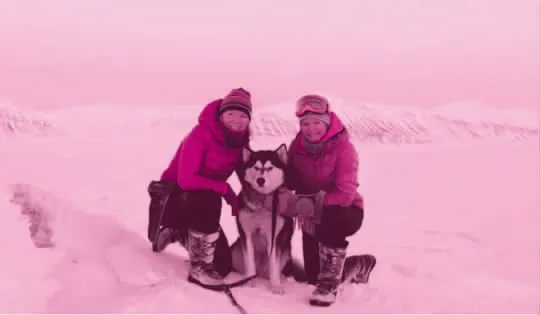山东李全忠
文中的主人公们去寒冷的北极住了长达两年。是什么让她们选择了这样一种生活呢?

?
难词探意
1.isolate/'aɪsəleɪt/v.使隔离;使孤立
2.session/'seʃn/n.会议
Sunniva Sorby and Hilde Fålun Strøm areisolatingthemselves in the High Arctic of Svalbard,Norway,about 78 degrees north of the Arctic Circle.It's the second winter the explorers will spend in a remote cabin with no running water or electricity to study,educate,and raise awareness of climate change.
They have an online Hearts in the Ice platform which connects students,scientists,environmental organizations,businesses,and anyone who cares about the planet.Last winter,they held live videosessionsvia a digital classroom and plan to do the same this year with a specific theme each month.The first kicked off on Dec.10 and 15 with programs on polar bears.
Sorby was born in Norway and raised in Canada and was part of the first team of women to ski to the South Pole in 1993.She has traveled to Antarctica more than 100 times as a history lecturer and naturalist/guide.Also born in Norway,Strøm has been living in Svalbard for 25 years.She has had more than 250 polar bear encounters and has made so many trips on a snowmobile that it equals a trip around the world.

They started Hearts in the Ice to raise awareness of climate change in polar regions and to inspire a global dialogue around it.They are using their time at the remote cabin Bamsebu to contribute to projects from organizations around the world as citizen scientists.Their original plan was to spend nine months at Bamsebu from September 2019 to May 2020 to connect with kids from around the world with satellite video calls two times per month and serve as citizen scientists collecting data for a total of seven ongoing research projects related to climate change.
According to Børge Damsgård,director of University Centre in Svalbard,Hearts in the Ice is more than a project,more than two brave women managing to stay on their own during a polar winter.It is a model for how scientists,industrial partners,explorers,artists and other stakeholders can meet in a common action to focus on polar climate change.They are following in the footsteps of other polar pioneers not to hunt for fur and skins,but knowledge and wisdom.
Reading Check
1.Why do the two women live in the High Arctic?
A.To challenge themselves.
B.To draw the public's attention.
C.To experience a different life there.
D.To raise people's awareness of climate change.
2.What can we know about the two women's first video session?
A.It was about polar bears.
B.It was aimed at students mainly.
C.It was criticized by many scientists.
D.It was popular because of the cabin.
3.What do the two women have in common?
A.Both of them are bear lovers.
B.Both of them are history lecturers.
C.Both of them were born in Norway.
D.Both of them made trips on snowmobiles.
4.What's Børge Damsgård's attitude to Hearts in the Ice?
A.Partial. B.Positive.
C.Mild. D.Neutral.
Language Study
熟词生义
She has had more than 250 polar bear encounters and has made so many trips on a snowmobile that itequalsa trip around the world.她遇见过北极熊250多次,并骑着一辆雪地摩托旅行了很多次,总
路程相当于环游世界。
equalv.比得上;与……相当
e.g.No amount of money can equal memories like that.再多的金钱也比不上那样的回忆。



